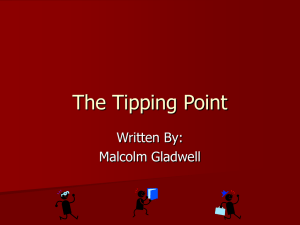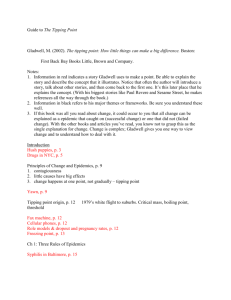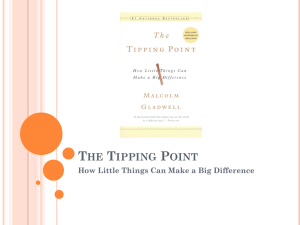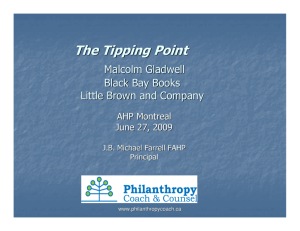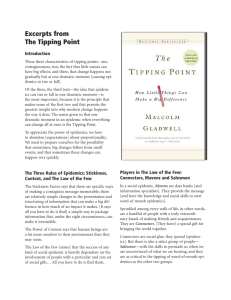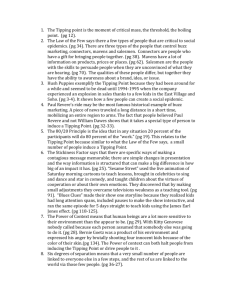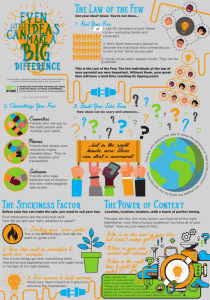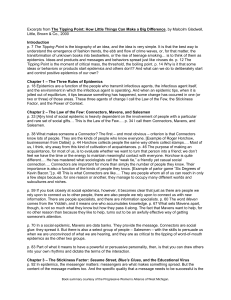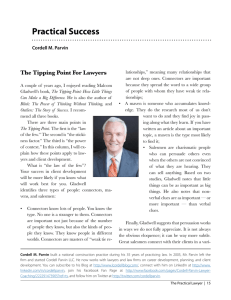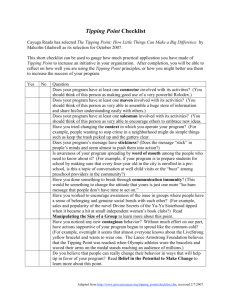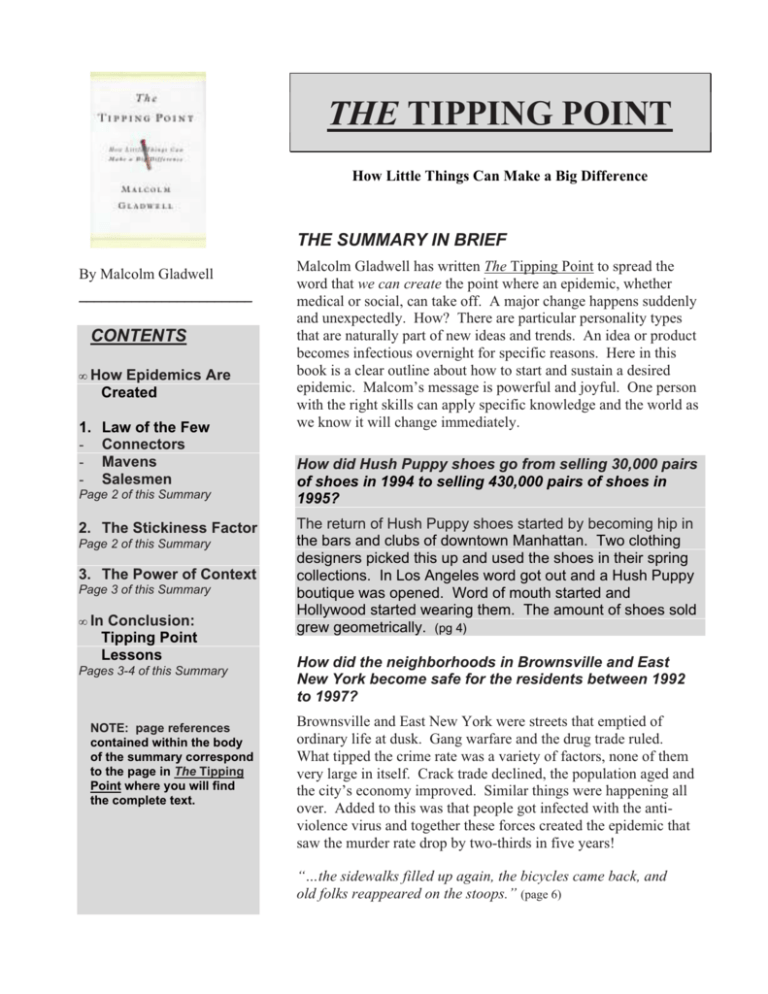
THE TIPPING POINT
How Little Things Can Make a Big Difference
THE SUMMARY IN BRIEF
By Malcolm Gladwell
_______________________
CONTENTS
•
How Epidemics Are
Created
1.
-
Law of the Few
Connectors
Mavens
Salesmen
Page 2 of this Summary
2. The Stickiness Factor
Page 2 of this Summary
3. The Power of Context
Page 3 of this Summary
•
In Conclusion:
Tipping Point
Lessons
Pages 3-4 of this Summary
NOTE: page references
contained within the body
of the summary correspond
to the page in The Tipping
Point where you will find
the complete text.
Malcolm Gladwell has written The Tipping Point to spread the
word that we can create the point where an epidemic, whether
medical or social, can take off. A major change happens suddenly
and unexpectedly. How? There are particular personality types
that are naturally part of new ideas and trends. An idea or product
becomes infectious overnight for specific reasons. Here in this
book is a clear outline about how to start and sustain a desired
epidemic. Malcom’s message is powerful and joyful. One person
with the right skills can apply specific knowledge and the world as
we know it will change immediately.
How did Hush Puppy shoes go from selling 30,000 pairs
of shoes in 1994 to selling 430,000 pairs of shoes in
1995?
The return of Hush Puppy shoes started by becoming hip in
the bars and clubs of downtown Manhattan. Two clothing
designers picked this up and used the shoes in their spring
collections. In Los Angeles word got out and a Hush Puppy
boutique was opened. Word of mouth started and
Hollywood started wearing them. The amount of shoes sold
grew geometrically. (pg 4)
How did the neighborhoods in Brownsville and East
New York become safe for the residents between 1992
to 1997?
Brownsville and East New York were streets that emptied of
ordinary life at dusk. Gang warfare and the drug trade ruled.
What tipped the crime rate was a variety of factors, none of them
very large in itself. Crack trade declined, the population aged and
the city’s economy improved. Similar things were happening all
over. Added to this was that people got infected with the antiviolence virus and together these forces created the epidemic that
saw the murder rate drop by two-thirds in five years!
“…the sidewalks filled up again, the bicycles came back, and
old folks reappeared on the stoops.” (page 6)
“The Tipping Point is the moment
of critical mass, the threshold, the
boiling point.” (pg 12)
_______________________________
How does change happen?
1. Contagiousness
2. Little causes have big effects
3. Change happens not gradually but at
one dramatic moment.
These together make the
TIPPING POINT
(page 9)
___________________________________________
The tipping point is the moment when a
business, illness, or behavior takes off
and becomes an epidemic with a
momentum of its own.
How Epidemics are Created:
1. Law of the few
Some people matter more than others in how
things happen: 80% of the work is done by 20%
of the participants, 20% of criminals commit 80%
of the crimes, and 80% of beer is drunk by 20%
of beer drinkers. (pg 19)
An epidemic requires concentrating
resources in a few key areas. Credit needs to be
given to the Connectors, Mavens, and
Salesmen. These are people with particular
skills that get the attention of the rest of us.
Connectors are the people that bring the
world together. A study was done in the late
1960’s by Stanley Milgram that showed people
have six degrees of separation, meaning that
within 6 steps, people we know connect us to
each other. (pg 34) The people that connect us
are not all equal; actually a very small number
of people know a lot of people. These people
have a natural and instinctive gift for making
social connections. They are comfortable with
having acquaintances and stay in touch with
them. Connectors know a variety of people and
have contacts in many different worlds, subcultures and niches.
Maven is a Yiddish word that means “one
who accumulates knowledge”. (pg 60) These
people have the information at hand and are
found in every socioeconomic group and area of
life. They watch the marketplace and help keep it
honest. Mavens are important – they have the
knowledge and social skills to start word of mouth
epidemics because they want to educate and
help to the rest of us.
Salesmen have the skills to persuade us
when we are unconvinced of what we are
seeing/hearing. They have a contagiousness in
their facial expressions and voice tones that we
are susceptible to. “It’s energy. It’s enthusiasm.
It’s charm. It’s likability. It’s all those things and
yet something more.” (pg 73) Verbal and
nonverbal clues are important. Persuasion works
in ways that are not fully appreciated and it gets
through our filtration system. Real salesmen will
pull us into their conversational rhythm and then
the terms of interaction can be dictated by them.
Mimicry of emotions creates an emotional
contagion. This means that some people are
“carriers” and some people are “senders”. (pg 85)
A salesman can persuade from the outside in an
external gesture can affect an internal decision.
2. The Stickiness Factor
Being sticky is being memorable.
Connectors, mavens, and salesmen need to use
this specific quality for our attention to be caught.
A changed word in an advertising phrase can
cause the product to come to our attention. The
details of an ad campaign are what usually catch
our attention. “ Winston tastes good LIKE a
cigarette should.” (pg 25) Improper grammar
caught an audience with this phrase and this
brand went to number two. Direct marketing
research has made a science out of studying
stickiness. What works is often cheesy or trivial
but it is specific. To large, too much, or too
confusing and the audience is gone.
Joan Gantz Cooney wanted to start an
epidemic of literacy in the 1960’s and use television
as the agent of infection. Her idea was called
Sesame Street. This show was deliberately and
painstakingly engineered to create stickiness.
Children were studied – they did not sit and zone
out at the television, there was much more
variation. Children could divide their attention
between a couple of activities, and this was not
done randomly. Children watched what they could
make sense of; looked away when they were
confused. One of the initial adjustments made on
2
the show was to integrate Big Bird and the real
people. That made it much stickier to the young
audience. Different segments were tested for
interest to kids with a slide show right beside it.
The attention of the kids was noted every seven
seconds: Sesame Street or slide show? The
slide show was the distracter. Observation of
attention is the best test to prove stickiness.
Information packaged in a simple way under the
right circumstances can make it irresistible –
how is this found?
3. The Power of Context
“Epidemics are sensitive to the conditions
and circumstances of the times and places in
which they occur.” (pg 139) Crime is contagious,
fashion trends are contagious, and are so
because of something physical, some feature of
the environment. The New York subway cleanup
and safety movement was successful in a large
part because the decision was made to no longer
tolerate graffiti or let patrons escape paying the
fee. These details were attended to with a lot of
persistence and the epidemic tipped the other
direction. The big problems don’t have to be
solved, attend to the details and all will follow.
The character of a human being depends on
context for its definition. Peer pressure and
community influence actually outweigh family
influence-and that is the power of context. One
experiment was done and called “the good
Samaritan.” It was found that a group of
seminarians would stop to help someone in need
only if certain conditions were present. (pg 163)
If they were in a hurry someone in need was
ignored. The context of the behavior is more
important in guiding actions than convictions of
heart or thoughts.
Rule of 150: This rule defines the optimum
number of people for using transactive memory.
Transactive memory is a joint memory system
and is based on an understanding about whom
is best suited to remember what kinds of
knowledge. This is done in relationships,
families, churches and work places. Humans
can only connect meaningfully with so many
others and that number seems to change after
150 people. This most effective group is our
social channel capacity. This number creates a
functional unit, a workable context.
A diffusion model can be used in figuring out
the role of connectors, mavens and salesmen.
These personalities can leap the gap between
the innovators and early adapters who are
visionaries and will try new things, no questions
asked. A bridge needs to be built between
innovators/early adapters and the early majority,
those people that are looking for a percentage of
improvement and will orient to new things as
long as safety nets are in place. Connectors,
mavens, and salesmen create the process of
distortion of facts for the early majority. This
process of distortion is done by a diffusion
model and change is made easier.
A diffusion model or rumor has certain parts
that can be defined and worked with to create
desired results. The story is leveled (details left
out), then sharpened (details that remain are
make more specific), and the assimilation
happens (the story is changed so it makes more
sense to the targeted audience). The message
is translated so that the rest of us in each group
can understand. Small, close knit groups have
the power to magnify the epidemic potential of a
message or idea. This relates back to the
number 150, “the maximum number of
individuals with whom we can have a genuinely
social relationship with, the kind of relationship
that goes with knowing who they are and how
they relate to us.” (pg 180)
_______________________________________________________
IN CONCLUSION
Tipping Point Lessons:
What is not obvious is often most
important.
1. To start epidemics it requires concentrating
resources in a few key areas. This is the law of the
few and to start a word of mouth epidemic use
Connectors, Mavens, Salesmen.
Test for stickiness!
2. The world as we know it does not accord
with our intuition. “The theory of the Tipping Point
requires that we reframe the way we think about
the world” (pg 257). The way people function and
communicate is often messy and opaque.
Believe that change is possible
and with the right impetus people
will transform their behavior.
3
Do not dismiss any of this as Band aid
solutions.... “the Band aid is an inexpensive,
convenient, and remarkably versatile
solution to an astonishing array of
problems..... The Band aid solution is
actually the best kind of solution because it
involves solving a problem with the
minimum amount of effort and time and
cost,...There are times when we need a
convenient shortcut, a way to make a lot out
of a little, and that is what Tipping Points,
in the end, are all about.” (pg 257)
This book has far ranging stories that illustrate
the Tipping Point. Stories to further explain the
law of the few, the stickiness factor, and the
power of context are easy to find. Take the next
step and apply what infects you to your social
relationships, family and work situations.
“...if there is difficulty and volatility in the
world of the Tipping Point, there is a large
measure of hopefulness as well. Merely by
manipulating the size of a group, we can
dramatically improve its receptivity to new
ideas. By tinkering with the presentation of
information, we can significantly improve its
stickiness. Simply by finding and reaching
those few special people who hold so much
social power, we can shape the course of
social epidemics. In the end, Tipping Points
are a reaffirmation of the potential for
change and the power of intelligent action.
Look at the world around you. It may seem
like an immovable, implacable place. It is
not. With the slightest push – in just the
right place – it can be tipped.”
(pg 259)
Copyright © 2001 Robert W. Jacobs Consulting, Inc. All rights reserved.
Robert W. Jacobs Consulting, Inc.
6027 Tory Lane
Chelsea, MI 48118-9437
Tel: 734-475-1058; Fax: 734-475-1068
4

